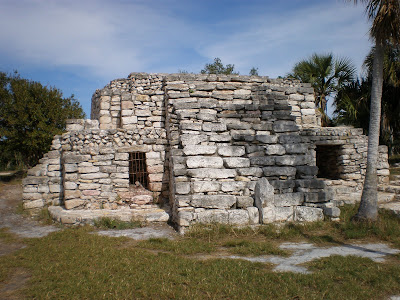 La cienega, or marshland, on the side of the road to Xcambo.
La cienega, or marshland, on the side of the road to Xcambo. View of the Temple of the Cross, the ball court, chapel and guest booth.
View of the Temple of the Cross, the ball court, chapel and guest booth.From Mérida we drove toward Progreso and followed the coast road east toward Telchac Puerto. After 20 kilometers, more or less, we saw the turnoff for Xcambo. The road is paved and in good condition. To our left were salt flats and on the right was marshland where bright pink flamingos, white storks, and gray herons were feeding in the reddened water. The ruin site was a pleasant surprise. There was a caretaker in a palapa monitoring the guest register, but there was no entrance fee.
Xcambo is a thought provoking site. The site was only excavated within the past ten years, and is still under reconstruction. The name Xcambo means either “Lugar de la donacella” (Place of virginity/maidenhood) or “Lugar de la luna menguante” (Place of the decreasing or ebbing moon). Its name has been spelled Xcambo and Xtambo. Spelling in Mayan is often inconsistent since it was a spoken language. Its writing was in hieroglyphics. Depending on who did the translating affected the final spelling of many of the places with Mayan names.
This was an important salt and saltfish trading post during Xcambo’s longest period of occupation, from 300 – 600 AD. It is thought 6,000 people lived in the surrounding areas. In 2001, 600 skeletal remains were found at the site. According to archeologists, the skeletons revealed a community relatively free of disease. Also found at Xcambo were several artifacts from Guatemala and Belize, leading experts to believe this was an important trading area.
There are two tall temples sitting at the north and south positions of the acropolis. The view of the shoreline from atop the pyramids is impressive. Along the pathways there are wells, or cenotes, and stones carved into basins. Of note were several circular patterns set in stone on the ground. Most interesting was the half Mayan, half Christian chapel. It was a simple palapa roof over thick blocks of stone. The altar brought pictures to my mind of sacrifices, but they well may be of the “Body of Christ” type rather than “body of enemy”. Most of the site was built of huge square boulders, but there were some eloquent smaller rocks also patterned in, including an inverted V-shaped doorway typically seen on the Ruta Puuc. Of the residential buildings that remained, we noticed the doorways were only a meter tall. We wondered if aluxes inhabited the area.
We sat on top of the tallest pyramid and enjoyed the panoramic view and fresh sea breeze as we listened to the palms and pandanus swaying in the otherwise unbroken silence of Mayan spirits.


The inverted V archway behind the chapel.
The chapel.
The Virgin of Guadalupe honored at the altar.
The chapel catches your eye as you enter the site.
Small temple next to Temple of the Cross.
Center circle is a cenote full of water. Carved basins hold water in the surrounding rocks.
Lots of these scattered around.
Circular bases also common.
The area was clean and manicured.























 The style of architecture here is very much like that of Chichén, although there are obvious Toltec and Puuc influences. The core of the site is smaller, and perhaps that is why for the first time I could almost envision the daily life of the original inhabitants. Although the grounds left you with the feeling that a lot of warring went on there, beyond that was the presence of all the people who lived there.
The style of architecture here is very much like that of Chichén, although there are obvious Toltec and Puuc influences. The core of the site is smaller, and perhaps that is why for the first time I could almost envision the daily life of the original inhabitants. Although the grounds left you with the feeling that a lot of warring went on there, beyond that was the presence of all the people who lived there.


 The painted murals were impressive. These colors have held up for over a thousand years. These are the predominant colors found at most ruins where color murals are found, as the Mayans were traders and shared knowledge, obviously including dyes that were permanent and good for painting stories on the walls.
The painted murals were impressive. These colors have held up for over a thousand years. These are the predominant colors found at most ruins where color murals are found, as the Mayans were traders and shared knowledge, obviously including dyes that were permanent and good for painting stories on the walls. The ball court is hidden behind the cenote. The trees you see are growing out of the center of the cenote.
The ball court is hidden behind the cenote. The trees you see are growing out of the center of the cenote. 


 The shadow of the snake god Kukulcan climbs up the great temple at sunrise on the day of the winter solstice, December 22, 2007.
The shadow of the snake god Kukulcan climbs up the great temple at sunrise on the day of the winter solstice, December 22, 2007. The Palacio is comprised of four main buildings and courtyards.
The Palacio is comprised of four main buildings and courtyards. Stelae found on site.
Stelae found on site.

















